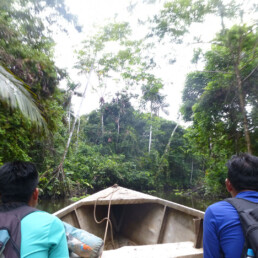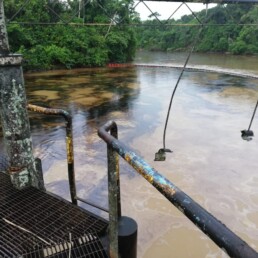Life on the Pastaza River
Sabaloyacu is a Quechua community of about 500 people on the banks of the Pastaza River in northeastern Peru, about 100 km from the Ecuadorian border. Cut off from national roads and electricity, the community depends entirely on river transport for connection, hunting, fishing, and trade.
Despite these challenges, Sabaloyacu is charting a sustainable path — replacing gasoline-powered boats with solar canoes to protect their territory, strengthen energy independence, and reduce river pollution.
Their 3,000-hectare territory (7,400 acres) lies within the Abanico del Pastaza Ramsar Site — one of South America’s most important wetlands, rich in diverse wetland types, vast peatlands that store carbon, and countless lakes and islands.
The region supports 79 species listed in CITES with 17 on the IUCN Red List. A 2002 WWF study recorded 265 bird species in 53 families. Loreto, the department encompassing Sabaloyacu, is recognized for its exceptional biodiversity, with more than 7,000 plant species, 800 bird species, and nearly 300 mammals — numbers that continue to grow as new species are identified.
Life on the Pastaza River
Sabaloyacu is a Quechua community of about 500 people on the banks of the Pastaza River in northeastern Peru, about 100 km from the Ecuadorian border. Cut off from national roads and electricity, the community depends entirely on river transport for connection, hunting, fishing, and trade.
Despite these challenges, Sabaloyacu is charting a sustainable path — replacing gasoline-powered boats with solar canoes to protect their territory, strengthen energy independence, and reduce river pollution.
Their 3,000-hectare territory lies within the Abanico del Pastaza Ramsar Site — one of South America’s most important wetlands, rich in diverse wetland types, vast peatlands that store carbon, and countless lakes and islands.
The region supports 79 species listed in CITES with 17 on the IUCN Red List. A 2002 WWF study recorded 265 bird species in 53 families. Loreto, the department encompassing Sabaloyacu, is recognized for its exceptional biodiversity, with more than 7,000 plant species, 800 bird species, and nearly 300 mammals — numbers that continue to grow as new species are identified.
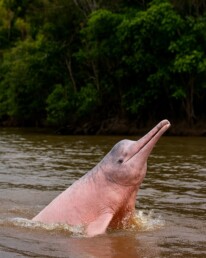
Amazon river dolphin, Endangered
A Vision Powered by the Sun
⚡ 1. Reduce the use of fossil fuels and their environmental impact
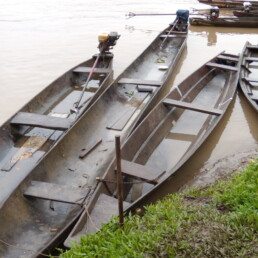
For communities deep in the Peruvian Amazon, mobility depends on small gasoline-powered boats known as peque-peques. Fuel is expensive, hard to access, and polluting — yet it remains the only way to travel between communities or reach fishing and hunting grounds.
The solar canoe offers a quiet, affordable, and renewable alternative. Powered entirely by sunlight, it reduces greenhouse gas emissions and prevents fuel spills that contaminate rivers and fish habitats. By replacing fossil fuels with solar energy, Sabaloyacu becomes a model for clean mobility in the Amazon.
🌿 2. Strengthen community energy sovereignty and autonomy
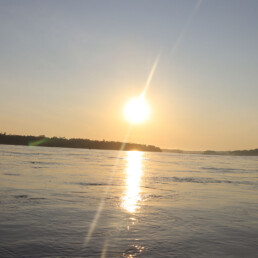
In remote regions like Loreto, the push for electrification often comes with the construction of roads — a process that opens the forest to logging, colonization, and cultural disruption.
With initial financial support from the Honnold Foundation and technical assistance from E-Tech Peru and the consortium Solar Canoes Against Deforestation (SCAD) Sabaloyacu can harness renewable energy through the solar canoe and its charging stations that can help meet local energy needs while preserving traditional ways of life. This transition empowers the community to control its own energy future.
🚤 3. Integrate solar canoe technology into economic and cultural life
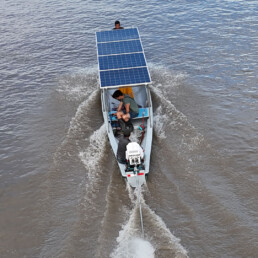
The solar canoe is more than transport — it’s a tool for economic resilience. It can be used for fishing, river trade, and ecotourism, offering a clean and quiet means of mobility that respects the rhythms of the forest and the river.
By eliminating the cost and noise of fuel engines, the canoe allows fishers to access wider areas without scaring away fish, and opens possibilities for low-impact tourism that values the beauty and silence of the Amazon. This project helps build local skills as well: community members are trained to assemble, operate, and maintain the canoes and the solar charging station— ensuring that the knowledge stays within the community.
Protecting 3,000 hectares (7,400 acres) of forest is a daily challenge. Fuel costs often limit patrols, leaving Indigenous territories vulnerable to illegal logging, poaching, and other incursions.
The solar canoe gives Sabaloyacu’s environmental monitors freedom to move — to reach distant areas, respond to threats quickly, and maintain consistent surveillance of their land.
The Pastaza region has long suffered from the environmental impact of oil exploration. Spills and leaks threaten rivers, fish, and the health of local communities.
Through the solar canoe project, monitors from Sabaloyacu can reach affected areas faster and document contamination events in real time. This partnership combines Indigenous stewardship with modern technology, creating a powerful model for community-led environmental monitoring and accountability.
From Vision to Impact
Social Impact
- Strengthens community autonomy and energy sovereignty.
- Reduces dependence on fossil fuels and external suppliers.
- Improves territorial protection and local surveillance capacity.
- Promotes solar energy as a culturally adaptable, sustainable solution.
Environmental Impact
- Decreases air, water, and noise pollution from fuel combustion.
- Protects aquatic and terrestrial wildlife by reducing disturbance.
- Increases the community’s capacity for environmental monitoring and response.
Together, We Move Forward
The solar canoe is more than a boat — it’s a symbol of independence and a path toward a cleaner, more sustainable Amazon.

